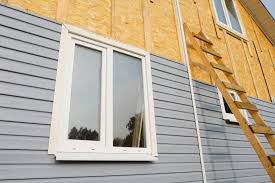Address
126 Maple Ave, Wallington, NJ 07057, USA
Work Hour
Open 24h




Siding repair involves fixing specific issues with a building’s exterior cladding to restore its appearance and protective function. This process can address problems such as cracks, holes, warping, or water damage. Repair work might include patching damaged areas, replacing sections of siding, or reapplying caulk to seams and joints to ensure a watertight seal. Effective siding repair not only enhances the curb appeal of a building but also protects its structural integrity by preventing further damage from water infiltration and other environmental factors.
Siding repair is a crucial maintenance task that addresses damage or wear to the exterior cladding of a building to maintain its aesthetic appeal and structural integrity. This type of repair is essential for preventing more severe issues such as water damage, pest infestations, and heat loss, which can all compromise the building’s overall durability and efficiency.
The siding repair process typically includes several detailed steps:
Inspection and Assessment: A thorough examination is conducted to identify all areas of damage, such as cracks, holes, rot, or loose and warped panels. This step determines the extent of the repair needed and the materials required.
Cleaning: The affected area is cleaned to remove dirt, debris, and old sealant to ensure that new materials adhere properly and to prevent the trapping of moisture.
Removal of Damaged Siding: Severely damaged pieces of siding are carefully removed. This may involve cutting out sections of siding while being careful not to damage surrounding areas that are in good condition.
Repair and Replacement: Depending on the type and extent of the damage, repairs may involve patching small holes or cracks with a compatible material, or completely replacing larger sections of siding. This step is crucial for restoring the visual uniformity and protective functionality of the siding.
Sealing and Caulking: Joints, seams, and edges are sealed with high-quality caulk to prevent water infiltration, which can lead to mold and structural damage. Proper sealing is essential for enhancing the longevity of the siding.
Painting or Finishing: If necessary, the repaired area is painted or finished to match the existing siding, improving the building’s overall appearance and providing an additional protective layer against environmental elements.
Final Inspection: The completed repair is inspected to ensure that it meets quality standards and effectively restores the siding’s functionality and appearance.
Siding repair can address various materials including vinyl, wood, fiber cement, and metal, each requiring specific techniques and materials for effective repair. Prompt and professional repairs not only enhance a building’s curb appeal but also protect its value and structural health by sealing out moisture and pests. This process is a cost-effective way to extend the lifespan of siding without the need for a full replacement.
The process of siding repair involves several critical steps to ensure the longevity and effectiveness of the repair, addressing any damage and restoring the siding to a good condition. Here’s a detailed breakdown of the process followed by a list of common types of siding repairs.
Inspection: The first step is a thorough inspection to assess the extent and type of damage. This helps in determining the best approach for repair and identifying any underlying issues that might have caused the damage.
Cleaning: Before beginning repairs, the affected area is cleaned to remove dirt, debris, and any loose material. This ensures a strong adhesion and a clean work area for applying new materials.
Removal of Damaged Sections: Any severely damaged or irreparable sections of siding are carefully removed. This might involve cutting out sections of siding, ensuring not to damage the good parts still in place.
Repairing or Replacing Damaged Siding: Depending on the extent of damage, the repair might involve patching small holes or cracks with appropriate materials or replacing whole sections with new pieces of siding that match the existing material and color.
Sealing: Seams and joints around the repaired or new sections are sealed with caulk to prevent water ingress, which can lead to further damage.
Finishing Touches: If the existing siding has a specific finish or color, the repaired sections may need to be painted or treated to match the surrounding areas seamlessly.
Cleanup and Final Inspection: After the repairs are complete, any resulting debris is cleaned up, and a final inspection is carried out to ensure the quality and integrity of the repair work.
Proper siding repair not only fixes visible damage but also protects the building from potential future issues, such as water damage or thermal inefficiency, maintaining the building’s aesthetic appeal and structural integrity.
